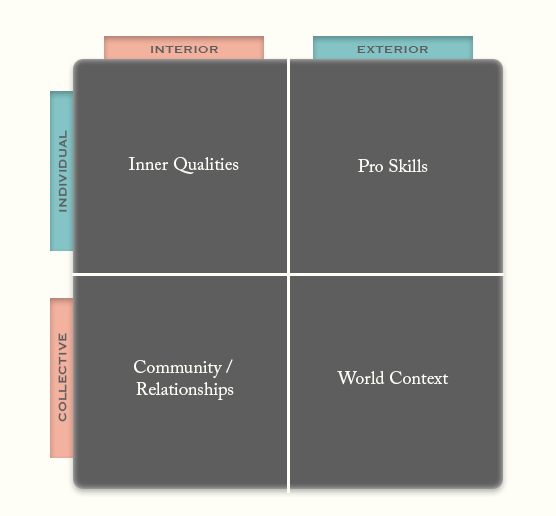Using Models
We love to use models – these are powerful tools that allow us to work with large concepts with a minimum amount of text.
A favorite overview model in Gaia U uses categories inspired by Ken Wilber’s All Quadrants, All Levels work (AQAL). Our simplified version serves to ensure we take a wide view of any topic (in this case, Learning and Livelihoods for a New Economy). Using it for your own purposes could assist you to think in a more integrated (integral) way as you work through all the quadrants and assemble your thoughts into a pattern of connected, joined-up, all-quadrant thinking.

In the upper left (UL) quadrant (Interior/Individual) we are considering our inner qualities and how these relate to (in this case) creating regenerative livelihoods, developing leadership talent and learning and unlearning). In the upper right (UR) quadrant (Exterior/Individual) we are looking at what behaviors and skills are required out in the world for these purposes and we are calling these, Pro (for professional) Skills.
We use the lower left (LL) quadrant (Interior/Collective) to think about how Community and Relationships impact livelihood and leadership projects whilst the lower right (LR) quadrant (Exterior/Collective) has to do with the ways that wider society influences our efforts and, indeed, to what extent society helps and hinders these efforts.
The content in this element uses this model and the focus is on the two upper quadrants – Inner Qualities (UL) and Pro-Skills (UR). The lower quadrants get attention in the elements that follow.
Each Book is labelled with the quadrant shorthand (UL, UR) to indicate which category it deals with. That said, the divisions between categories can be fuzzy meaning that a topic could straddle more than one quadrant and, indeed, you might feel it belongs in a different quadrant to the one we have chosen – that’s fine, the value of these models comes from the broad concepts, not from exact deployment).